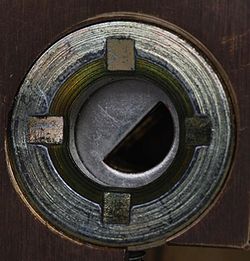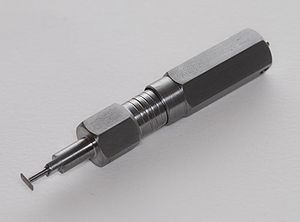Disc detainer: Difference between revisions
m (→Vulnerabilities: link) |
m (style) |
||
| (3 intermediate revisions by 2 users not shown) | |||
| Line 1: | Line 1: | ||
=Disc-detainer | |||
<span style="font-size: 188%;">Disc-detainer</span> | |||
---- | |||
[[File:Abloy Classic cylinder.jpg|thumb|right|text-top|250px|The original disc-detainer lock, the [[Abloy Classic]].]] | [[File:Abloy Classic cylinder.jpg|thumb|right|text-top|250px|The original disc-detainer lock, the [[Abloy Classic]].]] | ||
A '''Disc-detainer''' (or '''disc lock''', '''disk lock''') is a [[Lock|lock]] design that uses rotating discs as locking components. In most designs the discs interface with a [[Sidebar|sidebar]] | A '''Disc-detainer''' (or '''disc lock''', '''disk lock''') is a [[Lock|lock]] design that uses rotating discs as locking components. In most designs, the discs interface with a [[Sidebar|sidebar]] that prevents them from actuating the locking [[Bolt|bolt]] until the discs are properly rotated. Disc-detainers are primarily associated with [[Abloy]] locks, but [[ABUS]], [[Kryptonite]], and many other brands make them, too. | ||
The term ''disc tumbler'' usually refers to [[wafer]] designs, not disc-detainers. | The term ''disc tumbler'' usually refers to [[wafer]] designs, not rotating disc-detainers. | ||
__TOC__ | __TOC__ | ||
| Line 17: | Line 19: | ||
Add to me! | Add to me! | ||
==Principles of | ==Principles of operation== | ||
Disc-detainer keys have angled bitting cuts that rotate discs. When rotated properly, a sidebar will fall into a gate on the discs allowing the key to turn further and actuate the locking bolt to lock or unlock the lock. [[Master keying]] is provided by wide or duplicate true gates on the discs themselves. | Disc-detainer keys have angled bitting cuts that rotate discs. When rotated properly, a sidebar will fall into a gate on the discs allowing the key to turn further and actuate the locking bolt to lock or unlock the lock. [[Master keying]] is provided by wide or duplicate true gates on the discs themselves. | ||
<div align="center"><gallery> | <div align="center"><gallery> | ||
File:Abloy Exec key bitting.jpg|Disc-detainer keys have angled bitting cuts to properly rotate each disc. | File:Abloy Exec key bitting.jpg |Disc-detainer keys have angled bitting cuts to properly rotate each disc. | ||
File:Abloy_Disklock_discs_washers.jpg|Discs and washers used in a typical disc-detainer lock. | File:Abloy_Disklock_discs_washers.jpg |Discs and washers used in a typical disc-detainer lock. | ||
File:Abloy_Disklock_discs_normal.jpg|Discs in the normal (blocking) position. | File:Abloy_Disklock_discs_normal.jpg |Discs in the normal (blocking) position. | ||
File:Abloy_Disklock_discs_aligned2.jpg|Discs in the unlocked position; the [[sidebar]] can be retracted. | File:Abloy_Disklock_discs_aligned2.jpg |Discs in the unlocked position; the [[sidebar]] can be retracted. | ||
</gallery></div> | </gallery></div> | ||
| Line 34: | Line 36: | ||
; Washers | ; Washers | ||
: Washers are thin metal | : Washers (or spacers) are thin metal rings placed between each disc in the lock. Washers ensure each disc is turned individually by the appropriate bitting cut on the key. | ||
; Sidebar | ; Sidebar | ||
: The [[sidebar]] is the primary locking component of most disc-detainer locks. It is pushed into the [[cylinder]] or shell of the lock, preventing it from turning and actuating the [[bolt]] | : The [[sidebar]] is the primary locking component of most disc-detainer locks. It is pushed into the [[cylinder]] or shell of the lock, preventing it from turning and actuating the [[bolt]] mechanism until the sidebar is retracted. | ||
== Vulnerabilities == | == Vulnerabilities == | ||
| Line 54: | Line 56: | ||
==See also== | ==See also== | ||
* [[Lock]] | |||
* [[Sidebar]] | * [[Sidebar]] | ||
* [[Abloy]] | * [[Abloy]] | ||
* [[ | * [[ABUS_Plus_88/50 |ABUS Plus]] | ||
* [[Lockpicking]] | * [[Lockpicking]] | ||
[[Category:Disc-detainer locks| ]] | |||
[[Category:Locks]] | [[Category:Locks]] | ||
Latest revision as of 12:44, 25 December 2022
Disc-detainer

A Disc-detainer (or disc lock, disk lock) is a lock design that uses rotating discs as locking components. In most designs, the discs interface with a sidebar that prevents them from actuating the locking bolt until the discs are properly rotated. Disc-detainers are primarily associated with Abloy locks, but ABUS, Kryptonite, and many other brands make them, too.
The term disc tumbler usually refers to wafer designs, not rotating disc-detainers.
History
The first disc-detainer lock was the Abloy Classic, invented by Emil Henriksson in 1907.
Add to me!
Principles of operation
Disc-detainer keys have angled bitting cuts that rotate discs. When rotated properly, a sidebar will fall into a gate on the discs allowing the key to turn further and actuate the locking bolt to lock or unlock the lock. Master keying is provided by wide or duplicate true gates on the discs themselves.
Discs in the unlocked position; the sidebar can be retracted.
Components
- Discs
- A round metal disc, similar to a wafer, which is rotated by angled bitting cuts on the key. Discs have one or more true gates that must be properly aligned to allow the sidebar to retract and open the lock. Discs commonly use one or more false gates (typically gates too shallow to allow full sidebar retraction) to deter lockpicking attacks.
- Washers
- Washers (or spacers) are thin metal rings placed between each disc in the lock. Washers ensure each disc is turned individually by the appropriate bitting cut on the key.
- Sidebar
- The sidebar is the primary locking component of most disc-detainer locks. It is pushed into the cylinder or shell of the lock, preventing it from turning and actuating the bolt mechanism until the sidebar is retracted.
Vulnerabilities

Disc-detainers are subject to all the same attacks as traditional lock designs, though the tools used are less common. Lockpicking tools designed for disc-detainer locks closely resemble the 2-in-1 or 3-in-1 picks used with lever locks. The main anti-lockpicking feature of disc-detainers is the use of false gates (or notches), but more advanced designs include a disc locking system that prevents discs from being individually manipulated.
Given the proper tools and skill, all disc-detainer locks are subject to one or more of the following:



